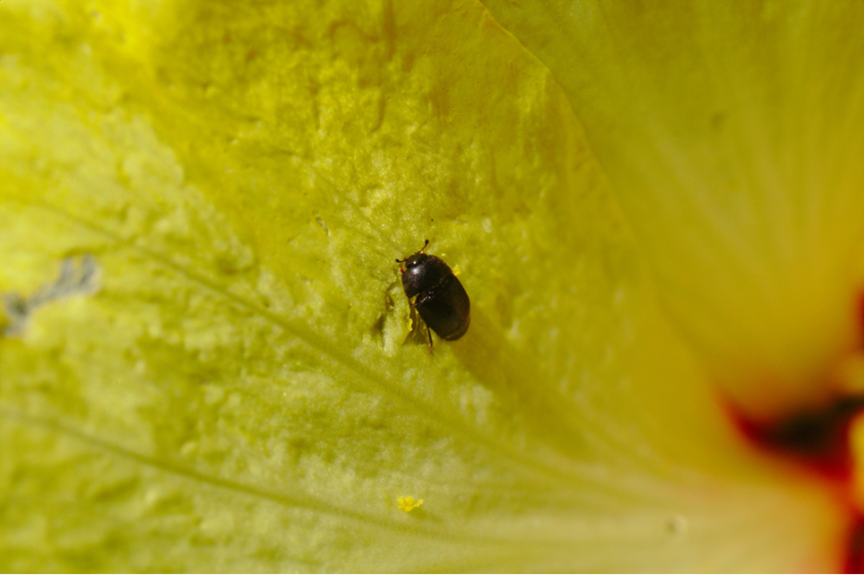Hibiscus Flower Beetle Control in Your Garden
Aethina concolor (Nitidulidae)

Aethina concolor (Nitidulidae)

Hibiscus Flower Beetle is a tiny native insect that has taken a liking to cultivated Hibiscus plants. The flower buds of Hibiscus are ideal places for Hibiscus Flower Beetle larvae to feed in safety. This feeding activity causes Hibiscus flowers to drop from the shrub. You can use this knowledge against the little pest. To break the life cycle simply pick up all fallen buds every few days and destroy them. This will significantly reduce the number of adult beetles later in the season.
Research has shown that adult beetles are attracted to white or light-coloured flowers. You could try trapping the beetles in white plastic containers part-filled with water and detergent laid on the ground near your Hibiscus plants. A more direct way would be to tap the beetles off the flowers straight into the soapy water. If you keep at it, you will significantly reduce their numbers and the amount of damage they cause.
Water and feed your Hibiscus plants appropriately, because healthy plants will bounce back from insect damage much more quickly than stressed pants. If you happen to prefer the darker flowering Hibiscus plants over the whites and other light flower colours, you are in luck – the Hibiscus Flower Beetle least prefers dark-coloured flowers.
The Hibiscus Flower Beetle (Aethina concolor) is a native pollen and nectar feeding beetle that may cause damage to the flowers of Hibiscus plants. The beetle is widely distributed in Australia, but is of most significance in the tropics and subtropics. Hibiscus Flower Beetle is a relatively common pest of cultivated Hibiscus plants in areas of southern Queensland and northern New South Wales.
The most significant damage caused by Hibiscus Flower Beetles occurs when adult beetles chew their way into Hibiscus flower buds to either feed on pollen and nectar, or for female beetles to lay their eggs.
Hibiscus Flower Beetle (Aethina concolor) is a member of the Nitidulidae family, which are collectively known as 'sap beetles'. The Small Hive Beetle (Aethina tumida) – a notorious beekeeping pest - is a close relative of the Hibiscus Flower Beetle. The Nitidulidae family also includes beetles of the Carpophilus genus that are pests of fruits, nuts and grains.
The adult Hibiscus Flower Beetle is black to dark brown, oval-shaped and about 3.5 mm long. The upper surface of the body is covered in short golden hairs (setae).
Hibiscus Flower Beetle larvae are cream-coloured with brown heads and their bodies are tapered at both ends.
Female Hibiscus Flower Beetles burrow their way into Hibiscus flower buds to lay their eggs inside, where the larvae hatch and feed. The larvae usually complete most of their development within flower buds that have fallen to the ground and remain moist. If flower buds fall and dry out, the larvae don't survive.
When mature, the larvae emerge from the flower buds and pupate in the soil. The entire life cycle can be completed in as little as two weeks during warm weather. There are many generations per year.
Hibiscus Flower Beetle mostly attack cultivated Hibiscus. They also may breed in weeds such as morning glory (Ipomoea indica) and bindweeds of the Calystegia genus.
Hibiscus Flower Beetles are pollen-feeding insects and may be seen in the flowers of other plants such as Magnolia but may not necessarily damage them.
Hibiscus Flower Beetle cause holes in petals. The damage is caused by beetles burrowing into opening buds to feed on pollen and nectar, or for female beetles to lay eggs.
Bud drop is another symptom. However, bud fall can also be caused by sap-sucking bugs that attack the base of flower buds such as Cotton Harlequin Bug and Green Vegetable Bug.
Hibiscus Flower Beetles are often only noticed in open flowers with holes in the petals. Check the plant and for dropped buds under Hibiscus plants.
White and pale-coloured flowers are significantly more attractive to Hibiscus Flower Beetles. Consider planting darker varieties.
Do this every few days to prevent any larvae inside from reaching maturity.
Knock Hibiscus Flower Beetles you find on open Hibiscus flowers into a container of soapy water.
By controlling weeds, you will be removing any alternate hosts where pests can thrive.